- Japan
- /
- Consumer Durables
- /
- TSE:6755
Is Fujitsu General Limited (TSE:6755) Expensive For A Reason? A Look At Its Intrinsic Value

Key Insights
- The projected fair value for Fujitsu General is JP¥1,713 based on 2 Stage Free Cash Flow to Equity
- Fujitsu General is estimated to be 22% overvalued based on current share price of JP¥2,083
- Our fair value estimate is 9.8% lower than Fujitsu General's analyst price target of JP¥1,900
Today we will run through one way of estimating the intrinsic value of Fujitsu General Limited (TSE:6755) by taking the forecast future cash flows of the company and discounting them back to today's value. One way to achieve this is by employing the Discounted Cash Flow (DCF) model. It may sound complicated, but actually it is quite simple!
Remember though, that there are many ways to estimate a company's value, and a DCF is just one method. Anyone interested in learning a bit more about intrinsic value should have a read of the Simply Wall St analysis model.
Check out our latest analysis for Fujitsu General
The Model
We're using the 2-stage growth model, which simply means we take in account two stages of company's growth. In the initial period the company may have a higher growth rate and the second stage is usually assumed to have a stable growth rate. To begin with, we have to get estimates of the next ten years of cash flows. Where possible we use analyst estimates, but when these aren't available we extrapolate the previous free cash flow (FCF) from the last estimate or reported value. We assume companies with shrinking free cash flow will slow their rate of shrinkage, and that companies with growing free cash flow will see their growth rate slow, over this period. We do this to reflect that growth tends to slow more in the early years than it does in later years.
A DCF is all about the idea that a dollar in the future is less valuable than a dollar today, and so the sum of these future cash flows is then discounted to today's value:
10-year free cash flow (FCF) estimate
| 2025 | 2026 | 2027 | 2028 | 2029 | 2030 | 2031 | 2032 | 2033 | 2034 | |
| Levered FCF (¥, Millions) | JP¥13.9b | JP¥10.4b | JP¥11.2b | JP¥11.8b | JP¥11.7b | JP¥11.6b | JP¥11.5b | JP¥11.5b | JP¥11.5b | JP¥11.5b |
| Growth Rate Estimate Source | Analyst x3 | Analyst x4 | Analyst x4 | Analyst x3 | Analyst x2 | Est @ -0.64% | Est @ -0.37% | Est @ -0.18% | Est @ -0.05% | Est @ 0.04% |
| Present Value (¥, Millions) Discounted @ 6.6% | JP¥13.0k | JP¥9.2k | JP¥9.3k | JP¥9.1k | JP¥8.5k | JP¥7.9k | JP¥7.4k | JP¥6.9k | JP¥6.5k | JP¥6.1k |
("Est" = FCF growth rate estimated by Simply Wall St)
Present Value of 10-year Cash Flow (PVCF) = JP¥84b
We now need to calculate the Terminal Value, which accounts for all the future cash flows after this ten year period. The Gordon Growth formula is used to calculate Terminal Value at a future annual growth rate equal to the 5-year average of the 10-year government bond yield of 0.3%. We discount the terminal cash flows to today's value at a cost of equity of 6.6%.
Terminal Value (TV)= FCF2034 × (1 + g) ÷ (r – g) = JP¥12b× (1 + 0.3%) ÷ (6.6%– 0.3%) = JP¥182b
Present Value of Terminal Value (PVTV)= TV / (1 + r)10= JP¥182b÷ ( 1 + 6.6%)10= JP¥96b
The total value, or equity value, is then the sum of the present value of the future cash flows, which in this case is JP¥179b. In the final step we divide the equity value by the number of shares outstanding. Compared to the current share price of JP¥2.1k, the company appears slightly overvalued at the time of writing. Remember though, that this is just an approximate valuation, and like any complex formula - garbage in, garbage out.

Important Assumptions
The calculation above is very dependent on two assumptions. The first is the discount rate and the other is the cash flows. If you don't agree with these result, have a go at the calculation yourself and play with the assumptions. The DCF also does not consider the possible cyclicality of an industry, or a company's future capital requirements, so it does not give a full picture of a company's potential performance. Given that we are looking at Fujitsu General as potential shareholders, the cost of equity is used as the discount rate, rather than the cost of capital (or weighted average cost of capital, WACC) which accounts for debt. In this calculation we've used 6.6%, which is based on a levered beta of 1.277. Beta is a measure of a stock's volatility, compared to the market as a whole. We get our beta from the industry average beta of globally comparable companies, with an imposed limit between 0.8 and 2.0, which is a reasonable range for a stable business.
SWOT Analysis for Fujitsu General
- Debt is not viewed as a risk.
- Earnings declined over the past year.
- Dividend is low compared to the top 25% of dividend payers in the Consumer Durables market.
- Annual earnings are forecast to grow faster than the Japanese market.
- Good value based on P/S ratio compared to estimated Fair P/S ratio.
- Dividends are not covered by earnings.
- Revenue is forecast to grow slower than 20% per year.
Next Steps:
Valuation is only one side of the coin in terms of building your investment thesis, and it shouldn't be the only metric you look at when researching a company. DCF models are not the be-all and end-all of investment valuation. Rather it should be seen as a guide to "what assumptions need to be true for this stock to be under/overvalued?" For instance, if the terminal value growth rate is adjusted slightly, it can dramatically alter the overall result. What is the reason for the share price exceeding the intrinsic value? For Fujitsu General, there are three fundamental aspects you should assess:
- Risks: For example, we've discovered 3 warning signs for Fujitsu General that you should be aware of before investing here.
- Future Earnings: How does 6755's growth rate compare to its peers and the wider market? Dig deeper into the analyst consensus number for the upcoming years by interacting with our free analyst growth expectation chart.
- Other High Quality Alternatives: Do you like a good all-rounder? Explore our interactive list of high quality stocks to get an idea of what else is out there you may be missing!
PS. Simply Wall St updates its DCF calculation for every Japanese stock every day, so if you want to find the intrinsic value of any other stock just search here.
New: AI Stock Screener & Alerts
Our new AI Stock Screener scans the market every day to uncover opportunities.
• Dividend Powerhouses (3%+ Yield)
• Undervalued Small Caps with Insider Buying
• High growth Tech and AI Companies
Or build your own from over 50 metrics.
Have feedback on this article? Concerned about the content? Get in touch with us directly. Alternatively, email editorial-team (at) simplywallst.com.
This article by Simply Wall St is general in nature. We provide commentary based on historical data and analyst forecasts only using an unbiased methodology and our articles are not intended to be financial advice. It does not constitute a recommendation to buy or sell any stock, and does not take account of your objectives, or your financial situation. We aim to bring you long-term focused analysis driven by fundamental data. Note that our analysis may not factor in the latest price-sensitive company announcements or qualitative material. Simply Wall St has no position in any stocks mentioned.
About TSE:6755
Fujitsu General
Develops, manufactures, sells, and service of air conditioner and telecommunications products and components.
Excellent balance sheet with moderate growth potential.
Market Insights
Community Narratives



